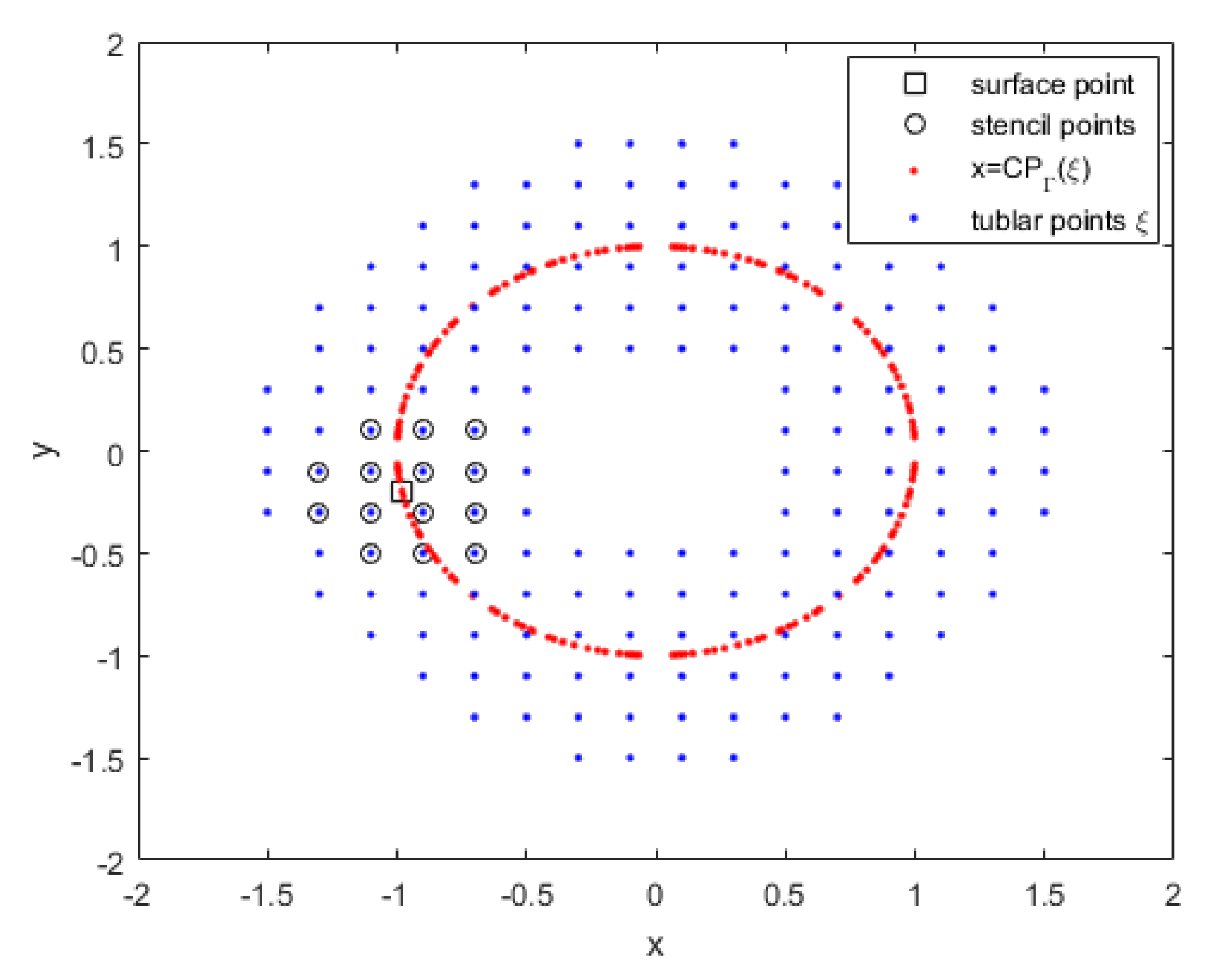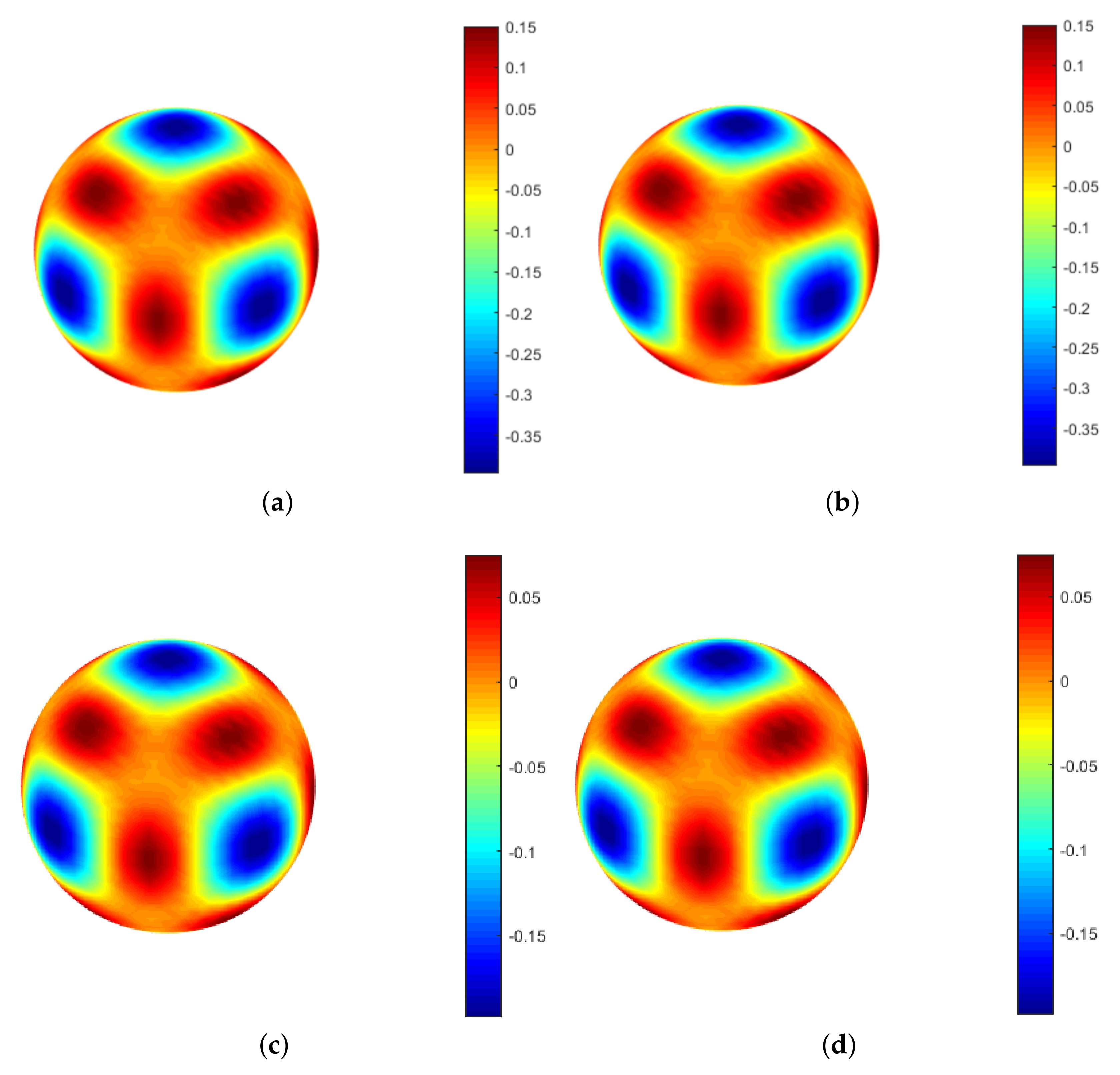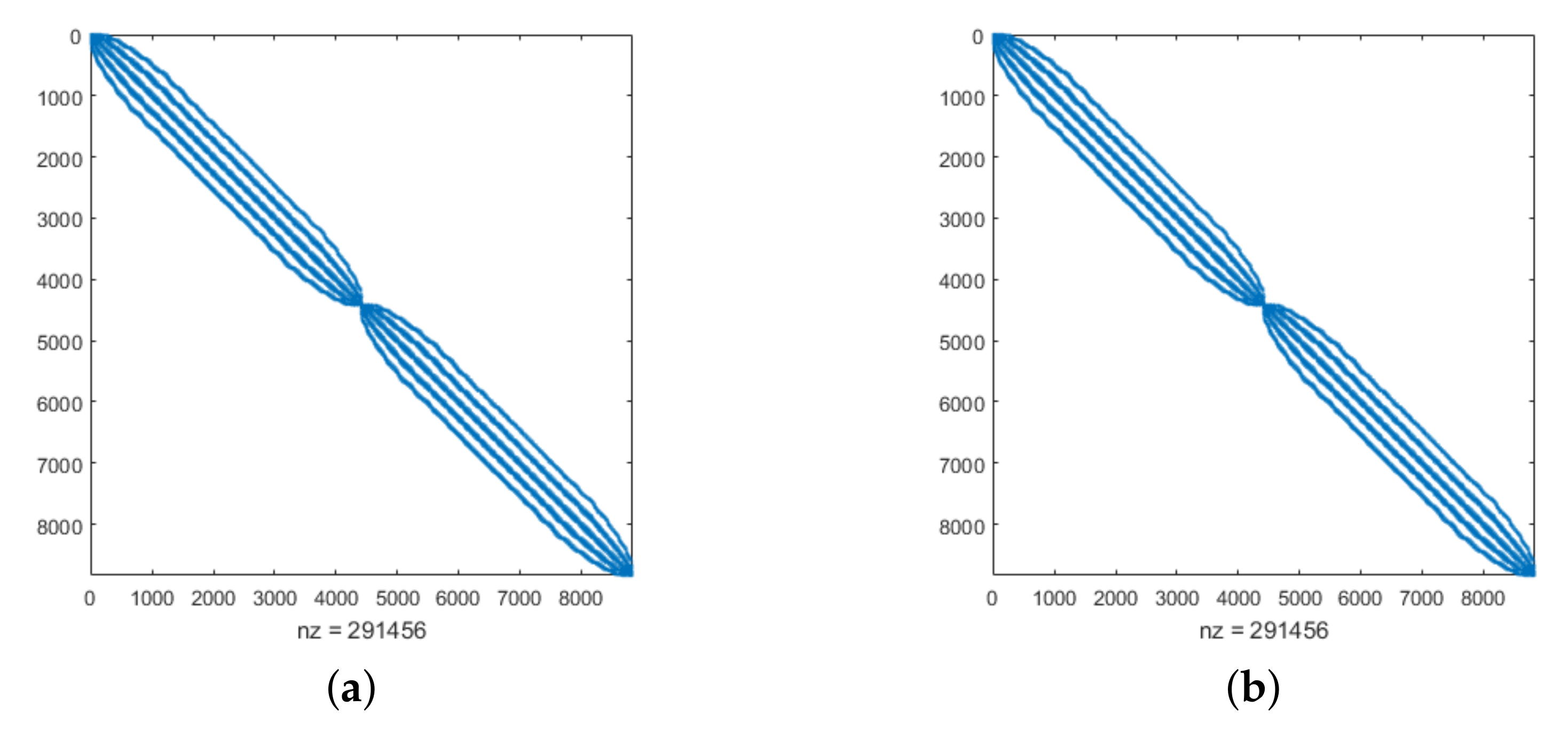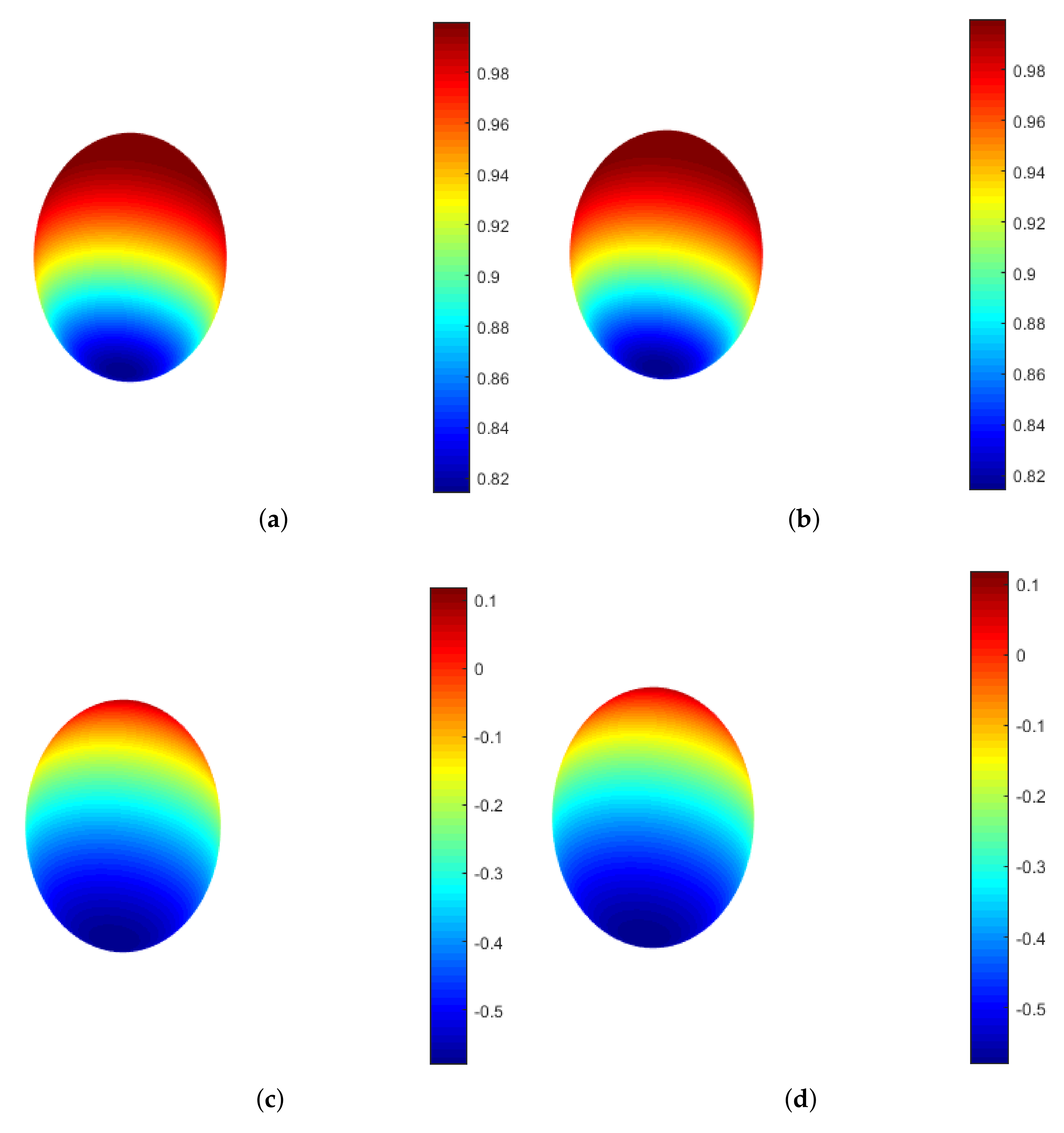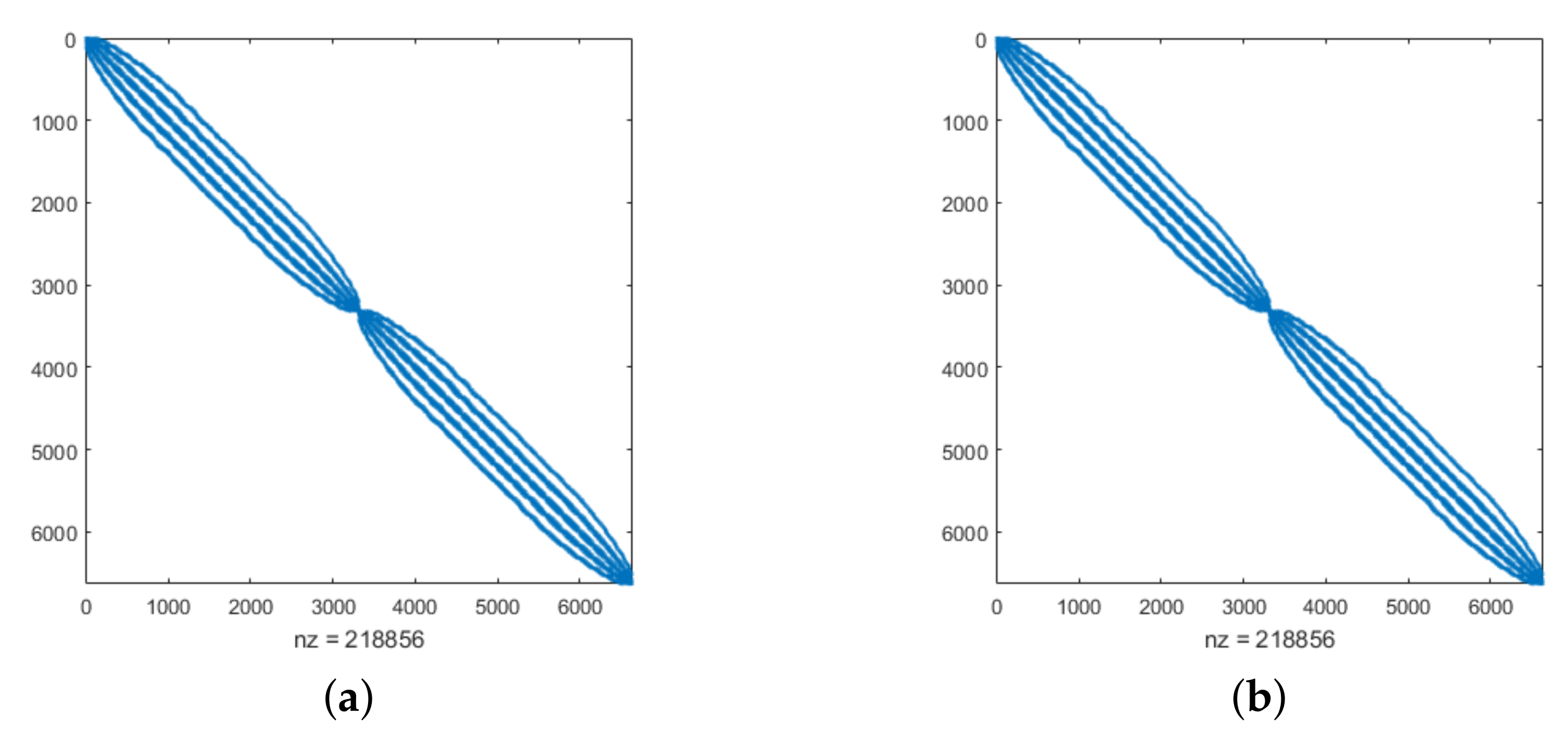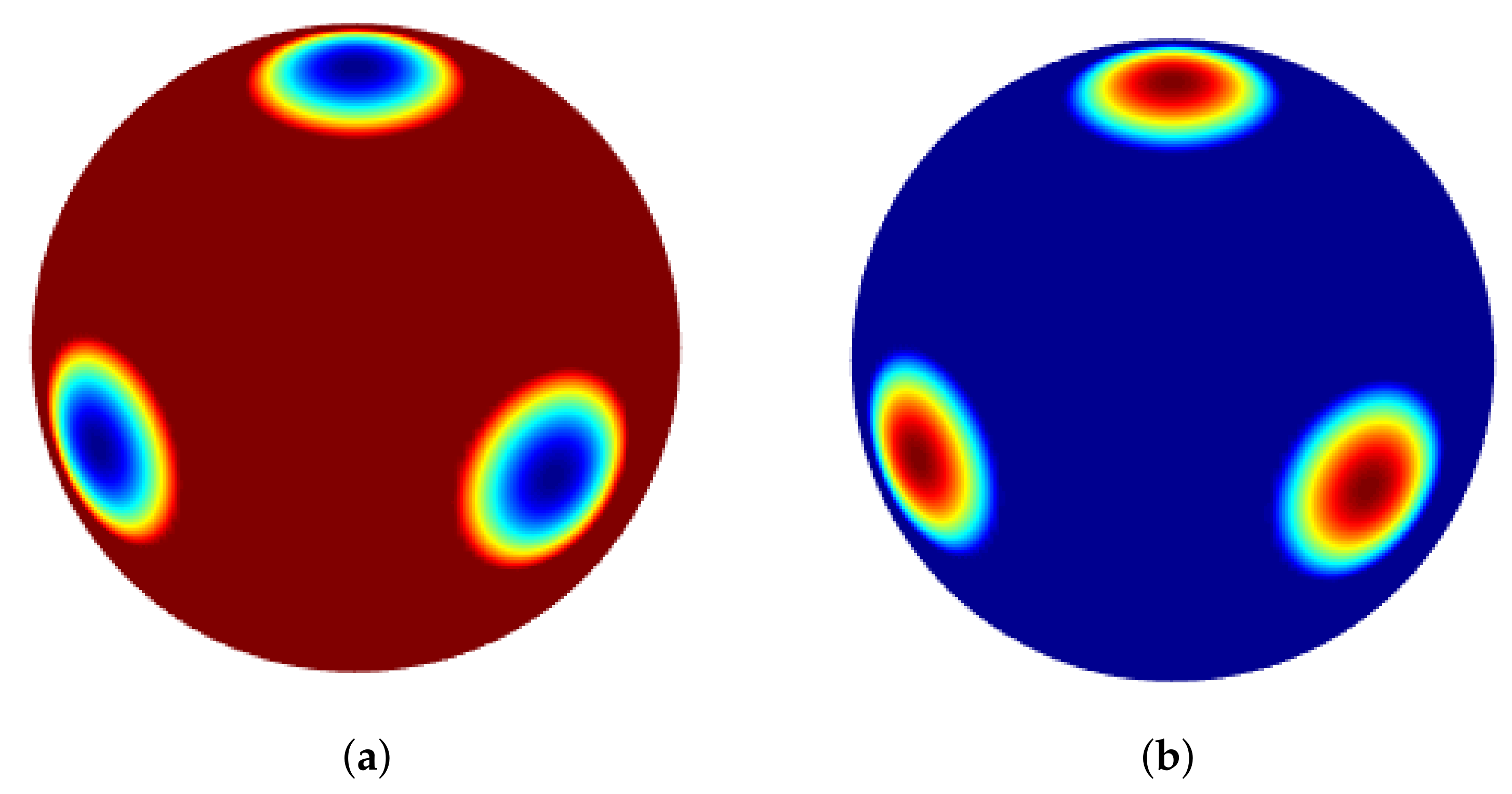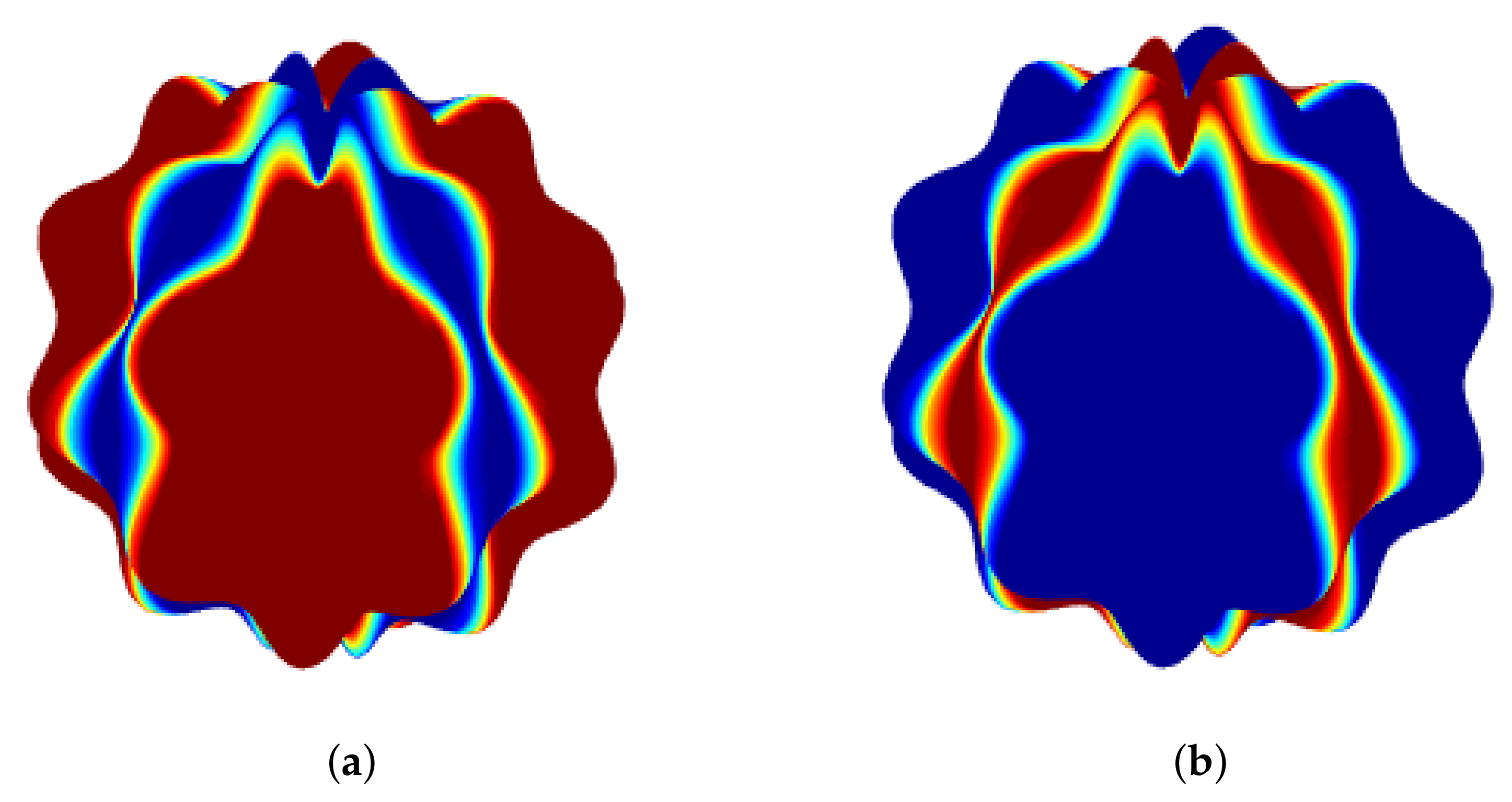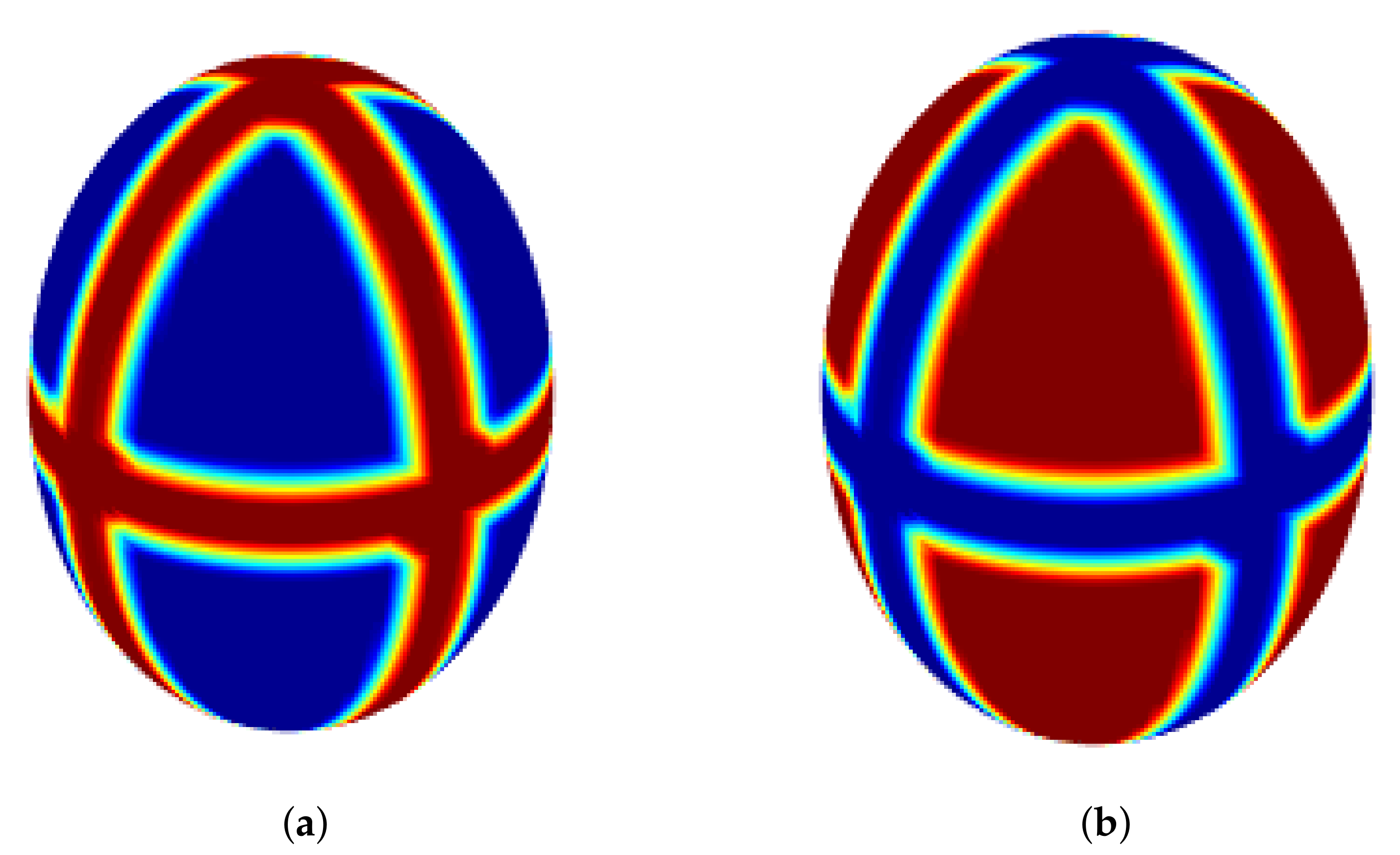Here, an accurate implicit formulation is proposed to discretize the problem (
2) in the time direction. For this purpose, firstly, the time interval
is uniformly decomposed into
M sub-intervals
, where
,
and
is time step size. Then, by substituting
in the system (
2), the following relations are obtained:
with
and
. The time integer derivative can be discretized at two sequential time levels,
and
n, as follows:
where
and
. In addition,
denotes the truncation error that is bounded by
. By substituting Equation (
4) in (
3), the following relations at the
th time level for
are obtained:
3.1. Closest Point Method
CPM is an embedding approach for numerically solving partial differential equations on surfaces. It considers a limited, narrow band surrounding the surface . Then, the closest point function maps each point of the embedding band to its closest point on the surface. CPM applies different standard numerical techniques to solve the embedding PDEs. Since it preserves the solution constant along with normal directions to the surface, the gradient and Laplacian over the embedding space all retrieve their inherent surface properties when restricted to the surface. The obtained embedding solutions are equal to the original PDEs’ solutions on the surface. In this work, an efficient local meshless method based on RBFs is combined with CPM.
We consider the surface
and
to be a point in the embedding space
. The closest point function for
is defined by
which identifies the closest point of
on the surface
.
In a neighborhood of the surface,
is
-smooth for a
-smooth surface
. Moreover, the embedding space
is considered a tubular neighborhood of surface
. To prevent the entry discontinuities into
, it should be assumed that the radius of the computational tube,
, has been chosen such that it consists only of points within a distance
of the surface
, where
is an upper bound on the curvatures of
[
37].
Regarding the CPM, solving the surface PDE on the surface is converted to solving a proper embedding PDE on the computational domain; the surface derivatives should be replaced with Cartesian derivative and closest points operators according to two principles [
33]:
Suppose V to be a function defined on that is constant along normal directions of . Then, at the surface, .
Suppose to be a vector field on that is tangent to and also tangent at all surfaces displaced by a fixed distance from . Then, at the surface, .
The first principle states that if a function is constant in the normal direction, it only varies along the surface. Moreover, the second principle explains that a flux that is directed everywhere along the surface can only spread out within the surface directions.
If
u is a function defined on the surface,
is constant along the directions normal to the surface; thus, the first principle implies
Since
is tangent to the distance function’s level-sets, applying the second principle yields the surface Laplacian, which is known as the Laplace–Beltrami operator in the following form:
More generally, we consider the surface diffusion operator
, where the diffusion coefficient is not constant and depends on position. In this case,
is tangent to the level surfaces, which implies
By combining the two principles, all surface differential operators in the governing problem can be replaced with the corresponding Cartesian differential operators. Therefore, by using the relation (
10), the surface Equations (
6) are changed to the embedding equations, which depend only on Cartesian derivatives as follows:
where the constants along the normal direction extension of
u and
v are denoted by
and
, respectively. The above relations are equivalent to
where
. Finally, the points are on the tubular computational domain, and the corresponding closest point on the surface forms the closest point representation. Therefore, a suitable platform was provided for performing a suitable numerical method in order to solve the embedding problem.
3.2. CPM Based on RBF-FD Technique
The radial basis function–finite difference (RBF-FD) method is a hybrid and advanced procedure in numerical analysis constructed by combining the beneficent characteristics of the radial basis function (RBF) and easy implementation of finite difference [
35,
36]. The main factor behind the RBF-FD method’s extension is to reduce the computational cost of global methods. Particularly, reducing computational cost in the face of the big problems is essential.
In this section, the RBF-FD method on the closest point representation is introduced. For this purpose, corresponding to each point of the surface
, a local domain containing
nearest points of the computational domain
is considered. The group of points in the local domain is called a stencil. Although the problem raised in this work is three-dimensional, a schematic view in two dimensions is shown to better understand the RBF-FD method combined with CPM.
Figure 1 is a schematic demonstration of the circular curve in the two-dimensional perspective. This figure shows an example of an RBF-FD stencil that consists of the
closest grid points to a particular surface point. The aim is to approximate a linear operator
at the point
on the surface
using a linear combination of the function value
in the corresponding stencil. In this work, the linear Cartesian operator
can be
, ∇, or the identity operator such that
where
and the surface operator
can be demonstrate the
,
, or identity operator. Here, to solve the time discretization embedding Equation (
12), we could apply CPM based on RBF-FD. For this purpose, for each scattered point
, such that
, we assume the stencil contains some points
. In the RBF-FD procedure, the operator
is approximated at the evaluation point
by a linear weighted combination of the functions
at
nearest neighboring points
. Therefore, we aim to identify weights
as follows:
The combined RBF and polynomial interpolant is assumed to be a linear combination of the radial and polynomial functions; thus, it takes the form
where
is a radial basis function,
is the
th monomial in the polynomial basis function in the space coordinates
, and
is the number of monomials. To solve for the unknowns, we force the interpolant to match the data at the point locations
where
is a radial basis function,
is the
th monomial in the polynomial basis function in the space coordinates
, and
is the number of monomials. Moreover, to find an unique result for unknown coefficients, the following
constraint orthogonality conditions are imposed
Equations (
15) and (
16) are arranged in a linear system of
equations for the
unknowns
as follows:
where the coefficient matrix
M is a non-singular
matrix [
16,
38], in which
and 0 is the
zero matrix. Therefore, solving the linear system (
18) yields the unknown coefficients as follows:
Evaluating the operator
of the interpolant at
and using relation (
20) give
Once multiplied,
gives the weights vector
for approximating
. Therefore, the solution vector
in relation (
14) could be determined in the following form:
Note that in the vector , the entries should be scrapped. Hence, the first components of vector are constructed of the weight vector corresponding to stencil points .
Therefore, for evaluation point
on the surface, the local approximation (
14) in the related stencil can be written in novel notation as follows:
Then, by computing
for all closest points
, the global sparse
matrix
could be assembled such that
where
and
For computing the numerical solutions of the problem (
12), each differential operator is replaced by the relation (
26) in the following form:
Therefore, relation (
27) can be rewritten as follows:
where the
matrices
,
,
, and
are defined in the following forms:
In numerical implementation to face the non-linear term
, a predictor–corrector Algorithm 1 is used.
| Algorithm 1 Predictor–corrector algorithm |
Consider initial guesses and whiledo Solve system ( 28) as follows: if and then , else and . end if end while
|
Moreover, for implementing the procedure, the thin plate spline (TPS) RBFs
and generalized multiquadric (GMQ) RBFs
are applied. These radial basis functions depend on scatter points on the computational domain, such as
through the radial variable
, which is the Euclidean distance between the point of interest
and a computational point
in three-dimensional space. The TPS belongs to
and has strictly conditionally positive definite radial functions of order
[
16,
38]. Moreover, The GMQ belongs to
, and for
, it has a strictly, conditionally positive definite order of one [
38]. Moreover, for
we have the standard multiquadric (MQ) RBFs. The accuracy and stability of the methods based on the GMQ radial basis functions depend on the shape parameter
c. Furthermore, a set of three-dimensional quadratic monomial basis functions
is used to implement the procedure. It is noteworthy that adding polynomials and constructing the augmented RBFs, which guarantee the non-singularity and uniquely solvability of the linear system when using conditionally positive RBFs, could improve the accuracy of the numerical results [
39]. Therefore, adding polynomials could improve the stability of the procedure using RBFs. Furthermore, the shape parameters’ sensitivity is reduced by augmenting the polynomials into RBFs, and the range of selection of the shape parameters is extended [
40].
To verify the numerical stability of the proposed method, the noise effects on error estimates are investigated. For this purpose, we suppose that the initial solutions and in the numerical process are perturbed to and , respectively. Therefore, the influence of noise on error estimates is studied for perturbation solutions and at .
